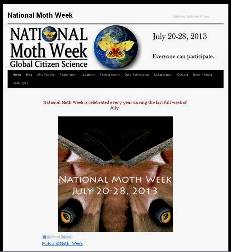July 20-28, 2013 is National Moth Week! Many locations are holding mothing events during this week. How will you celebrate? This is an opportunity to get involved in citizen science!
Moths are incredibly diverse, and there are many more species than most people realize. I also never appreciated how beautiful many of them are until I saw an exhibit at a natural science museum a few years ago.
 The web site offers links to some resources, including online identification guides and online tips for photographing these nocturnal beauties. Also see the Butterfiles and Moths of North America (BAMONA) database, which also offers a stunning image gallery. Data for this web site comes from all kinds of sources, including museums, published sources, professional scientists, and maybe you! Citizen scientists can submit observations and photographs. The Wisconsin Dept. of Natural Resources also has lists (with links to images) of rare and declining (“watch list”) butterflies and moths.
The web site offers links to some resources, including online identification guides and online tips for photographing these nocturnal beauties. Also see the Butterfiles and Moths of North America (BAMONA) database, which also offers a stunning image gallery. Data for this web site comes from all kinds of sources, including museums, published sources, professional scientists, and maybe you! Citizen scientists can submit observations and photographs. The Wisconsin Dept. of Natural Resources also has lists (with links to images) of rare and declining (“watch list”) butterflies and moths.
Andersen Library has resources too! Search HALCat to find books such as Moths (3rd-floor Main Collection, QL542 .M35 2002) and the Lepidopterist Society‘s Basic techniques for observing and studying moths & butterflies (3rd-floor Main Collection, QL542 .W56 2000). Search article databases to find articles including “Moth diversity in three biofuel crops and native prairie in Illinois” (Insect Science, 2013, v.20:no.3, pp.407-419. doi:10.1111/j.1744-7917.2012.01530.x) and “Uncommon vision” (National Geographic, 2002, v.201:no.5, pp.52-).
If you’d appreciate assistance with finding materials, please ask a librarian.
Happy mothing.

Oh the poor moth. The first thing I think of when I hear “moth” is ACK! I’m sorry, moth.